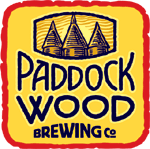 You gotta hand it to the folks at Paddock Wood. While most breweries are doing fruit wheat ales, saisons or witbiers for their summer seasonals, Paddock Wood has the nerve to release a porter in the summer. And not any ordinary porter, either. Black Friars is tip of the hat to 1600s London. The label offers a clear explanation: “Blackfriars Theatre was the most innovative and structurally advanced theatre in 1608 London. We have brewed a beer fit for nobility, recreating some of the brewing methods used in London at the time.”
You gotta hand it to the folks at Paddock Wood. While most breweries are doing fruit wheat ales, saisons or witbiers for their summer seasonals, Paddock Wood has the nerve to release a porter in the summer. And not any ordinary porter, either. Black Friars is tip of the hat to 1600s London. The label offers a clear explanation: “Blackfriars Theatre was the most innovative and structurally advanced theatre in 1608 London. We have brewed a beer fit for nobility, recreating some of the brewing methods used in London at the time.”
Yes, Paddock Wood has brewed a historic porter. In the summer. Mind you this is not their only summer release (they are busy with new beer these days) but it is part of their summer arsenal. While that may seem an odd choice, I think it is actually remarkably appropriate. They released a version of the beer last year and sold it through the various theatre groups in Saskatchewan. This year it is a more general release (although only available in Saskatchewan, to the best of my knowledge).
Paddock Wood has a thing about porter, apparently. London Porter is part of their regular line-up, so if they were going to do another, they needed to make it different.
What makes it a 17th century ale? Two things. First, some of the malt was hand-roasted, much like brewers did in that age, so it has a more artisanal, uneven character than the professionally roasted malts today. Second, at least for this year’s version, they added some Brettanomyces to the beer to give it a distinctive earthy tart tang. Of course, in the day before Louis Pasteur, almost all beer would have infections of Brett and Lactobacillus, causing it to slowly sour over time.
I was lucky enough to have a couple of bottles shipped to me, and sat down last night to give one of them a careful sipping. The beer pours dark brown with a mahogany hue building a consistent light tan head. There is a slight haze present. The aroma is chocolate, toffee, raisin, brazil nut and minor roastiness all wrapped up with a moderate, clean sour sharpness.
At first, soft toffee, chocolate and dark fruit highlight the flavour with a hint of roast playing in the background. But an earthy tang moves in fairly quickly to make those flavours elusive, at least in terms of “front of house” flavour.The tartness stops just short of being too much, allowing for a mixture of flavours to work their way through the beer. The end result is a fascinating blend of sweeter porter character and a Flanders Ale-esque refreshingness . Tartness makes the beer more quenching and not quite so heavy, which is why I suggest it may be an appropriate choice for a summer beer.
This is a creative, interesting, multi-layered beer with a nice connection to historical brewing. One can almost imagine at 17th century Londoner sipping on a very similar beverage after a theatre performance.

August 26, 2013 at 10:57 AM
Hi, Jason,
You are SO knowledgeable about beer. This is exciting to read and you are so eloquent with your descriptions, I’m going to rush right out and try this one.
I’m connected with Ways of Water Institute and am curious to explore what living water could do for our local beer. It’s been widely used in Europe in many applications including beer-making. What better place to test it than with small operations.
Are you game? We could do a 90 day trial and compare qualities.